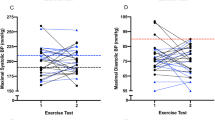Abstract
It has not been fully clarified whether exercise blood pressure (BP) in young adult men and women is useful to predict future BP, especially in Asian people. A long-term prospective study was conducted in graduates of a medical school in Japan; 138 men and 76 women whose mean age was 19.8 and 19.2, respectively, at baseline. A 5-min exercise tolerance test was performed at baseline, and BP immediately after exercise was measured. BP at 50% intensity exercise was also calculated. Multiple regression analysis was carried out to clarify the relationship of exercise BP at baseline to follow-up BP after an average of 12 years. In multivariate-adjusted models, the relationship of systolic blood pressure (SBP) at follow-up was stronger to SBP immediately after exercise (F=7.7, P=0.006) than to resting SBP (F=3.7, P=0.055) in men. The models in men showed that SBP immediately after exercise was a stronger predictor of follow-up SBP than SBP at 50% intensity exercise, and the results were similar for diastolic blood pressure (DBP) in men. For SBP in women, resting SBP was the strongest predictor of follow-up SBP (F=14.3, P<0.001), and exercise SBP was not significant predictor. For DBP in women, any DBP at rest or after exercise was not significantly related to DBP at follow-up. In young adult men, SBP and DBP immediately after exercise would be a stronger predictor of future SBP and DBP rather than BP at rest. However, in young adult women, resting SBP rather than exercise SBP would be better to predict future SBP.
This is a preview of subscription content, access via your institution
Access options
Subscribe to this journal
Receive 12 digital issues and online access to articles
$119.00 per year
only $9.92 per issue
Buy this article
- Purchase on Springer Link
- Instant access to full article PDF
Prices may be subject to local taxes which are calculated during checkout
Similar content being viewed by others
References
Miura K et al. Relationship of blood pressure to 25-year mortality due to coronary heart disease, cardiovascular diseases, and all causes in young adult men: The Chicago Heart Association Detection Project in Industry. Arch Intern Med 2001; 161: 1501–1508.
McCarron P, Smith GD, Okaha M, McEwen J . Blood pressure in young adulthood and mortality from cardiovascular disease. Lancet 2000; 355: 1430–1431.
Vasan RS et al. Impact of high-normal blood pressure on the risk of cardiovascular disease. N Engl J Med 2001; 345: 1291–1297.
Singh JP et al. Blood pressure response during treadmill testing as a risk factor for new-onset hypertension: The Framingham Heart Study. Circulation 1999; 99: 1831–1836.
Matthews CE et al. Exaggerated blood pressure response to dynamic exercise and risk of future hypertension. J Clin Epidemiol 1998; 51: 29–35.
Miyai N et al. Exercise BP response in subjects with high-normal BP: exaggerated blood pressure response to exercise and risk of future hypertension in subjects with high-normal blood pressure. J Am Coll Cardiol 2000; 36: 1626–1631.
Tsumura K et al. Blood pressure response after two-step exercise as a powerful predictor of hypertension: The Osaka Health Survey. J Hypertens 2002; 20: 1507–1512.
Dlin RA, Hanne N, Silverberg DS, Bar-Or O . Follow-up of normotensive men with exaggerated blood pressure response to exercise. Am Heart J 1983; 106: 316–320.
Manolio TA et al. Exercise blood pressure response and 5-year risk of elevated blood pressure in a cohort of young adults: The CARDIA Study. Am J Hypertens 1994; 7: 234–241.
Klag MJ et al. Serum cholesterol in young men and subsequent cardiovascular disease. N Engl J Med 1993; 328: 313–318.
Karvonen MJ, Kentala E, Mustala O . The effects of training on heart rate. Ann Med Exper Biol Fenn 1957; 35: 307–315.
American College of Sports Medicine Position Stand. The recommended quantity and quality of exercise for developing and maintaining cardiorespiratory and muscular fitness and flexibility in healthy adults. Med Sci Sport Exer 1998; 30: 975–991.
Drory Y, Pines A, Fisman EZ, Kellermann JJ . Exercise response in young woman with borderline hypertension. Chest 1990; 97: 298–301.
Lund-Johansen P . Blood pressure response during exercise as a prognostic factor. J Hypertens 2002; 20: 1473–1474.
MacDonald JR . Potential causes, mechanisms, and implications of post exercise hypotension. J Hum Hypertens 2002; 16: 225–236.
Sun M, Jones R . Accuracy relationship of blood pressure devices between the AMMI SP 10 standard and the British Hypertension Society protocols. Biomed Instrum Technol 1999; 33: 62–70.
Author information
Authors and Affiliations
Corresponding author
Rights and permissions
About this article
Cite this article
Nakashima, M., Miura, K., Kido, T. et al. Exercise blood pressure in young adults as a predictor of future blood pressure: a 12-year follow-up of medical school graduates. J Hum Hypertens 18, 815–821 (2004). https://doi.org/10.1038/sj.jhh.1001749
Received:
Revised:
Accepted:
Published:
Issue Date:
DOI: https://doi.org/10.1038/sj.jhh.1001749
Keywords
This article is cited by
-
Relationship Between Cardiorespiratory Fitness, Baseline Blood Pressure and Hypertensive Response to Exercise in the Ferrari Corporate Population
High Blood Pressure & Cardiovascular Prevention (2022)
-
Hemodynamic variables during exercise in childhood and resting systolic blood pressure levels 6 years later in adolescence: the European Youth Heart Study
Journal of Human Hypertension (2011)



